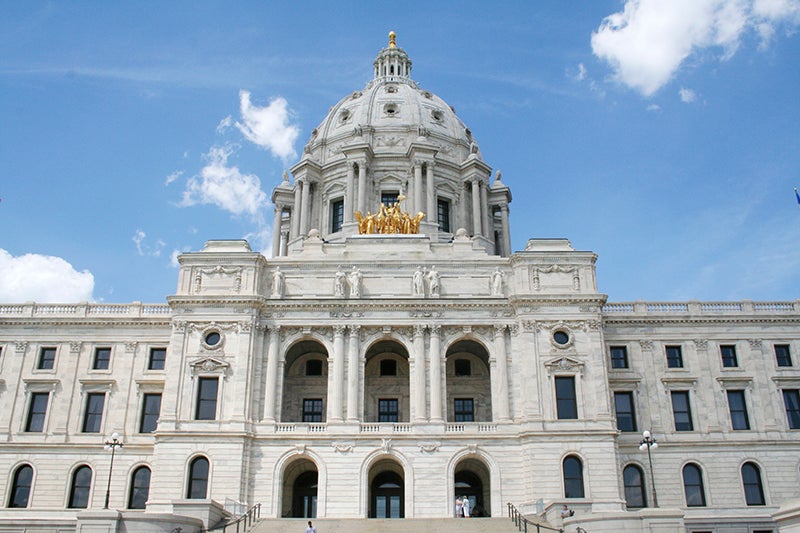Minnesota budget projected surplus at $2.4 billion, but warning lights blinking
Published 5:03 pm Wednesday, December 6, 2023
|
Getting your Trinity Audio player ready...
|
By Dana Ferguson, Minnesota Public Radio News
Minnesota’s projected budget surplus was pegged at $2.4 billion in a new report Wednesday from the state finance agency, which also raised concerns about patterns down the line.
The financial forecast suggests Minnesota’s economy continues to chug along in the near term but could face strains in the years ahead.
“Minnesota’s budget and economic outlook remains stable in the current biennium, but a significant structural imbalance constrains the budget outlook” for the next budget that begins in July 2025, officials wrote in a summary posted ahead of the full forecast release.
The summary noted “higher estimates in health and human services and education,” the two biggest drivers of state expenses.
The report sets up another tug-of-war over how to divvy up the funds. Lawmakers approved a new two-year budget in May, aided by another big surplus.
“We need to be measured in how we approach this,” Gov. Tim Walz told reporters Wednesday before defending DFL spending decisions last session as vital investments in Minnesota’s future and for the well-being of school children. “If we’re cautious on this, we balance out in the out years.”
Among the unexpected short-term challenges, the report noted that the state’s decision earlier this year to pick up more costs around school breakfasts and lunches regardless of a family’s income has turned out to be much more expensive than initially expected.
The program was slated to cost about $400 million over two years, but the forecast indicates it will be about $80 million more expensive due to costs of food and lower federal participation in the meals program than officials had anticipated.
Walz added that he expects to put forward only limited budgetary measures next year.
‘Need to be very thoughtful’
Revenue updates in recent months had offered clues that a major surplus was building. An October report showed the state would bring in roughly $2.4 billion more than anticipated — driven by higher collections of taxes and fees.
Minnesota Management and Budget Commissioner Erin Campbell said the state’s trajectory looks positive — at least in the short term.
With the COVID-19 pandemic largely in the rearview mirror, Campbell said this forecast should come with less volatility.
“Our hope is that we’ve returned to being positioned to more accurately predict or forecast what we think our revenues and expenditures are going to look like,” Campbell said.
Some of that excess will automatically be added to the state’s rainy day fund, which currently sits at more than $2.85 billion. A report released by Minnesota Management and Budget in October recommended a slightly higher level.
The remainder is up for grabs as lawmakers return to St. Paul in February. The DFL-led Legislature passed a $72 billion two-year budget earlier this year. Lawmakers are expected to tackle a supplemental budget bill and construction projects bill in 2024.
Democrats left cash aside last year for a capital investment bill in case Republicans won’t support one, House Speaker Melissa Hortman, DFL-Brooklyn Park said ahead of the Wednesday presentation. The state requires a higher threshold of support to take on debt, which means that Democrats need GOP buy-in to issue bonds to pay for projects.
“If there is bipartisan cooperation, we would see a bonding bill in the nature of $1.7 billion or so,” Hortman said. “And if it is Democrats only that would like to do a bonding bill, then we’ll have a state bonding bill in the neighborhood of $800 million.”
After historic state spending last year, Republican leaders said the Legislature should focus on getting more money back to taxpayers.
House Minority Leader Lisa Demuth, R-Cold Spring, on Wednesday said DFL lawmakers “squandered” the chance to send the $17.5 billion budget surplus posted in February back to Minnesotans as tax cuts.
“Democrats’ reckless spending has now set us on the path to have a budget deficit in the coming years. This could have been avoided if Democrats had even an ounce of fiscal responsibility,” Demuth said in a statement. “Democrats put their insatiable appetite for spending ahead of the needs of Minnesotans and we will all be paying for their fiscal insanity for years to come.”
Campbell, the state’s budget commissioner, offered a cautionary view on the long-term forecast, noting that projected spending and inflation calculations show the state’s surplus down to only $82 million at the end of fiscal 2027.
That’s a balance that “provides little cushion when you consider the size of our projected state budget,” she told reporters. “Such a small balance, together with a structural imbalance, suggests policymakers will need to be very thoughtful when making budget decisions this next year.”






